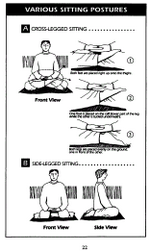Meditation tools

DOWNLOAD BOOK:
For the Stilling of Volcanoes
by Ven. Sujiva
PDF, 143 KB, www.buddhanet.net


Insight meditation itself is a process of processes. At first we try to keep ourselves afloat with strong continuous mindfulness. After that, the practice becomes a journey of discoveries.
This booklet lays out the tools of meditation very neatly and precisely, making it all the more easier for a practitioner to choose the one she wants and use it, step by step.
It all begins with the mind and you do not have to go all the way to realize, as Ven Sujiva tells us, that it can be quite destructive when it erupts. The benefits of keeping our minds under check can be quite substantial, not the least of which can be an ability to maintain our balance when we go about negotiating the volatile situations we encounter every day in our lives. That is commonsense, perhaps, but finding a way to do it is not at all easy.
The mind is predominantly likened to a volcano in this booklet. "When you are in a fit of anger, consumed by lust, or buried by delusion, you are undergoing an eruption. It strikes terror in and around you, and you may lose some good things in life. Although it may not take lives, it can, and may even be, more lethal than an actual volcano," he says.
The main "control" is mindfulness. And mindfulness is the line between sanity and insanity. "If you are a meditator, you’ll have a fighting chance and maybe even end up saner than anyone else. But they may still call you mad because you are different," he says.
And then he goes on to decribe three basic meditation techniques for attaining mindfulness - ways to get a hold on the main control, as he puts it. These are walking meditation, sitting meditation, mindfulness of daily activities.
Much of the book is about these modes of meditation, which are explained in detail with a lot of attention being paid to their practical aspects. The descriptions are supported with illustrations and charts - the part on walking meditation for instance, includes a sketch that shows the various levels of awareness with which we could move our feet when we practice it.
So too is the part on sitting meditation. Ven Sujiva's flow chart tells us what we should focus on during our practice. And mindfulness of daily activites is in some ways an extention of this basic approach to everything we do from day to day.
Ven Sujiva then goes on to distinguish between insight and concentration. Insight involves the realization of the "real Nature" of the the world and cutting through the bonds of conditioning that prevents us from knowing it. It also means knowing about its essential characteristics, one of which is impermanence.
Those who do not have the patience for lengthy descriptions of doctrines and texts on which the practice is based, would find this an ideal introduction to meditation. It is not that Ven Sujiva skips them. He goes straight to the initial steps on the path to mindfulness.